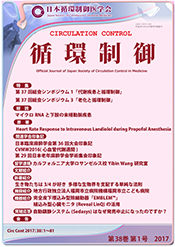Volume 38, Issue 1
Displaying 1-10 of 10 articles from this issue
- |<
- <
- 1
- >
- >|
-
2017Volume 38Issue 1 Pages 2-4
Published: 2017
Released on J-STAGE: May 11, 2017
Download PDF (460K) -
2017Volume 38Issue 1 Pages 5-8
Published: 2017
Released on J-STAGE: May 11, 2017
Download PDF (849K) -
2017Volume 38Issue 1 Pages 9-10
Published: 2017
Released on J-STAGE: May 11, 2017
Download PDF (633K) -
2017Volume 38Issue 1 Pages 11-12
Published: 2017
Released on J-STAGE: May 11, 2017
Download PDF (504K)
-
2017Volume 38Issue 1 Pages 13-15
Published: 2017
Released on J-STAGE: May 11, 2017
Download PDF (845K) -
2017Volume 38Issue 1 Pages 16-18
Published: 2017
Released on J-STAGE: May 11, 2017
Download PDF (483K) -
2017Volume 38Issue 1 Pages 19-20
Published: 2017
Released on J-STAGE: May 11, 2017
Download PDF (331K) -
2017Volume 38Issue 1 Pages 21-23
Published: 2017
Released on J-STAGE: May 11, 2017
Download PDF (553K)
-
2017Volume 38Issue 1 Pages 24-34
Published: 2017
Released on J-STAGE: May 11, 2017
Download PDF (695K)
-
2017Volume 38Issue 1 Pages 35-39
Published: 2017
Released on J-STAGE: May 11, 2017
Download PDF (235K)
- |<
- <
- 1
- >
- >|
